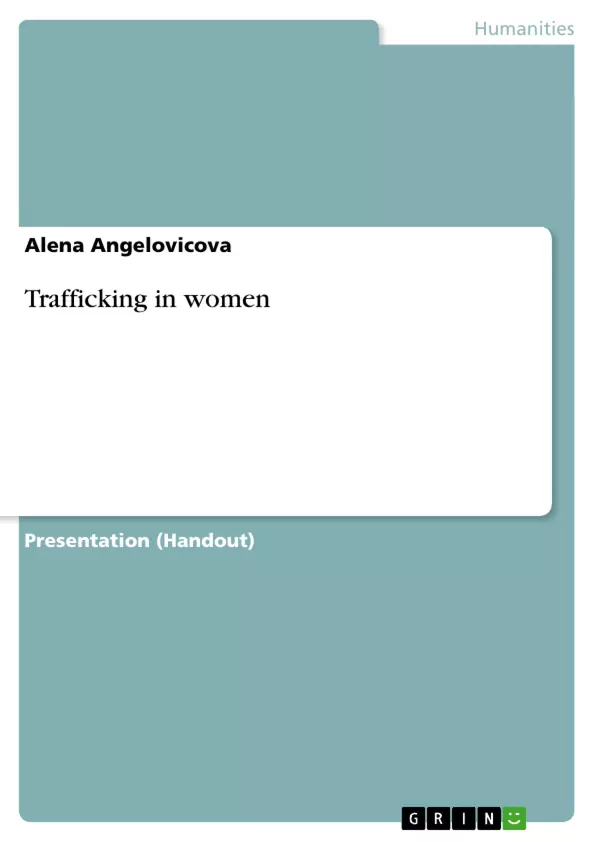The main scope of the presentation on trafficking in women is to outline the main theoretical perspectives of feminists on prostitution generally and prostitution in the context of sex-trafficking. The presentation will consider some states to examine their legal provisions regulating prostitution (Israel, Sweden and the Netherlands) and then it will focus on the international instruments covering trafficking in women. The position of the UN office for Drugs and Crime in combating human trafficking will be examined too. Lastly, the conclusion will be drawn from the consideration of the dichotomy of forced and voluntary prostitution in context with trafficking.
Inhaltsverzeichnis (Table of Contents)
- The scope of the presentation on the trafficking in women
- Theoretical and policy perspectives of feminists on prostitution generally and on the prostitution in context of trafficking in women
- Structuralist perspective
- Individualist perspective
- The negatives and positives of abolitionism (structuralist approach) and individualism (legalization) towards prostitution and the trafficking in practice of Sweden, the Netherlands, and Israel
- Sweden
- The Netherlands
- Israel
- International instruments on prostitution/trafficking in women
- The position of the United Nations office on drugs and crime
- The dichotomy between the forced and the voluntary prostitution
Zielsetzung und Themenschwerpunkte (Objectives and Key Themes)
The presentation aims to provide a comprehensive overview of feminist theoretical perspectives on prostitution, specifically in the context of trafficking in women. It examines the legal regulations surrounding prostitution in Sweden, the Netherlands, and Israel, while also exploring the role of international instruments in combating trafficking. The presentation delves into the position of the UN Office on Drugs and Crime in combating human trafficking, and finally, analyzes the distinction between forced and voluntary prostitution within the context of trafficking.
- Feminist perspectives on prostitution
- Legal regulation of prostitution in various countries
- International instruments on trafficking in women
- Role of the UN Office on Drugs and Crime
- Distinction between forced and voluntary prostitution
Zusammenfassung der Kapitel (Chapter Summaries)
The first section introduces the scope of the presentation, outlining its focus on feminist theories on prostitution and its connection to trafficking. It also highlights the examination of legal provisions in selected countries and the role of international instruments.
The second section dives into two main feminist theoretical perspectives on prostitution: the structuralist perspective, which views prostitution as a form of slavery, and the individualist perspective, which advocates for the legalization of prostitution as a form of sex work.
The third section compares the advantages and disadvantages of abolitionism (structuralist approach) and legalization (individualist approach) towards prostitution and trafficking, using Sweden, the Netherlands, and Israel as case studies.
Schlüsselwörter (Keywords)
The primary focus of this presentation revolves around prostitution, trafficking in women, feminist theory, legal regulation, international instruments, UN Office on Drugs and Crime, forced prostitution, and voluntary prostitution.
- Quote paper
- Alena Angelovicova (Author), 2006, Trafficking in women , Munich, GRIN Verlag, https://www.grin.com/document/74762



